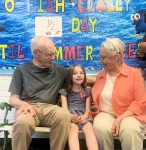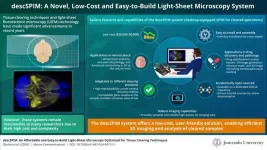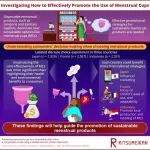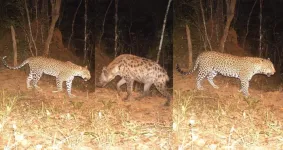(Press-News.org) Waltham — July 2, 2024 — American Indian/Alaska Native (AI/AN) women with breast cancer have consistently lower rates of breast reconstruction after mastectomy compared to non-Hispanic White women, reports a paper in the July issue of Plastic and Reconstructive Surgery®, the official medical journal of the American Society of Plastic Surgeons (ASPS). The journal is published in the Lippincott portfolio by Wolters Kluwer.
"Despite an upward trend in reconstruction, AI/AN women continue to be less likely to undergo breast reconstruction," comments Jane Hui, MD, MS, of University of Minnesota, Minneapolis. "While our findings point to some possible approaches to reducing this disparity, it will be essential to also determine Native women's opinions related to breast reconstruction."
Focus on factors affecting breast reconstruction in AI/AN women
Using data from the National Cancer Database, the researchers identified 1,980 AI/AN women and 414,036 non-Hispanic White women who underwent mastectomy for breast cancer between 2004 and 2017. Annual breast reconstruction rates were compared between groups, along with factors associated with decisions about reconstruction.
The two groups differed in some important characteristics. American Indian/Alaska Native women had higher rates of other medical diagnoses (comorbidity), 20% versus 12%; were more likely to have public health insurance, 49% versus 20%; and more likely to undergo single-breast (unilateral) mastectomy.
Over the 13-year study period, breast reconstruction increased in both groups: from 13% to 47% for AI/AN women and from 29% to 62% from non-Hispanic White women. After adjustment for other factors, AI/AN women remained nearly one-half less likely to undergo reconstruction.
Other factors associated with lower reconstruction rates included older age, earlier year of diagnosis, more advanced cancer, unilateral mastectomy, public insurance, and living in an area of lower educational attainment. Within the AI/AN group, reconstruction was more likely for younger women; those with more recent diagnosis, less-advanced cancer, and less comorbidity; and those living in urban areas or areas with a higher level of educational attainment.
Insights for addressing breast reconstruction disparity in Native women
Breast reconstruction after mastectomy has known benefits for some, including improved quality of life and body image. However, breast reconstruction is a personal decision – there is "no optimal proportion" of patients who should opt for reconstruction, Dr. Hui and colleagues note.
American Indian/Alaska Native women face a wide range of health disparities and barriers to medical care, including elevated rates of chronic health conditions, later diagnosis and higher mortality from breast cancer. "Complicating the healthcare environment in which AI/AN receive medical care is chronic underfunding of the Indian Health Service (IHS), implicit bias against AI/AN, and fraught relationships between physicians and AI/AN patients," the researchers write.
Their study offers insights into factors associated with the lower rate of breast reconstruction for AI/AN women with breast cancer. "Multidisciplinary efforts to improve care delivery to AI/AN women may continue to minimize disparities through earlier diagnosis and treatment," Dr. Hui and coauthors conclude. "Simultaneously, qualitative research into AI/AN perspectives on breast cancer care could improve shared decision-making between physicians and AI/AN patients, empowering AI/AN women to choose post-mastectomy reconstruction if they so desire."
Read Article: Disparities in post-mastectomy reconstruction use among American Indian and Alaska Native women
Wolters Kluwer provides trusted clinical technology and evidence-based solutions that engage clinicians, patients, researchers and students in effective decision-making and outcomes across healthcare. We support clinical effectiveness, learning and research, clinical surveillance and compliance, as well as data solutions. For more information about our solutions, visit https://www.wolterskluwer.com/en/health.
###
About Wolters Kluwer
Wolters Kluwer (EURONEXT: WKL) is a global leader in information, software solutions and services for professionals in healthcare; tax and accounting; financial and corporate compliance; legal and regulatory; corporate performance and ESG. We help our customers make critical decisions every day by providing expert solutions that combine deep domain knowledge with technology and services.
Wolters Kluwer reported 2023 annual revenues of €5.6 billion. The group serves customers in over 180 countries, maintains operations in over 40 countries, and employs approximately 21,400 people worldwide. The company is headquartered in Alphen aan den Rijn, the Netherlands.
For more information, visit www.wolterskluwer.com, follow us on LinkedIn, Facebook, YouTube and Instagram.
END
American Indian/Alaska Native patients less likely to undergo breast reconstruction
Disparity in reconstruction persists for AI/AN women, reports Plastic and Reconstructive Surgery®
2024-07-02
ELSE PRESS RELEASES FROM THIS DATE:
Prosocial influencers can promote societal cooperation
2024-07-02
A modeling study suggests that influential neighbors can be as effective as despotic leaders at promoting social cooperation. Prosocial behaviors can be difficult to sustain in large societies over the long term, as people give into the temptation to defect to strategies that prioritize the wellbeing of themselves and their immediate family. Stefani Crabtree and colleagues constructed a general theoretical framework to explore how cooperation could arise and be maintained in a large society. The authors explore three possible ...
SRF launches the SYNGAP1 missense account with Nordmoe family donation
2024-07-02
Mill Valley, CA – June 18, 2024 SRF has established a dedicated account to support research regarding SYNGAP1 missense variants. This account is being launched with a $10,000 donation from Dennis and Janet Nordmoe. This is a cause close to their hearts, as their granddaughter Olivia was diagnosed with SYNGAP1-Related Disorder (SRD) caused by a missense variant earlier this year.
Missense Research: Neglected to Date
“Most diagnosed SYNGAP1-Related Disorder (SRD) patients have protein truncating variants (PTV) as opposed to missense variants. Virtually all PTVs are assumed to have the ...
Design and development of a novel light sheet fluorescence microscope
2024-07-02
Three-dimensional (3D) imaging of organs and tissues is vital as it can provide important structural information at the cellular level. 3D imaging enables the accurate visualization of tissues and also helps in the identification of pathological conditions. However, achieving successful 3D imaging necessitates specific prerequisites, including the preparation of 'cleared' tissue samples—biological specimens rendered transparent by removing light-scattering components like lipids to ...
How to promote menstrual cups as an economic and sustainable option
2024-07-02
In recent decades, single-use plastics have pervaded modern societies, causing a significant surge in plastic pollution that exacts a heavy toll on our environment. Addressing this issue requires prioritizing sustainable alternatives to single-use plastics wherever feasible.
Disposable menstrual products are a notable contributor to plastic waste, with billions of sanitary napkins and tampons being discarded every year. Despite the availability of sustainable options like menstrual cups (MCs), consumer preference for single-use products ...
Spotted apex predator being pressured by spotted pack hunters – and it's our fault
2024-07-02
Who’s stronger? A solitary leopard or cackle of hyenas? And which is best at getting along with humans?
University of Copenhagen researchers closely studied this in a large East African natural area surrounded by rural settlements. The study demonstrates that the presence of humans has a direct impact on the competitive relationship between the two large predator species: leopards (Panthera pardus) – the iconic spotted feline and the spotted hyena (Crocuta crocuta) – a kleptoparasite and pack hunter known for its comical ...
True scale of carbon impact from long-distance travel revealed
2024-07-02
The reality of the climate impact of long-distance passenger travel has been revealed in new research from the University of Leeds.
Despite only accounting for less than 3% of all trips by UK residents, journeys of more than 50 miles (one way) are responsible for 70% of all passenger travel-related carbon emissions.
The disparity is even greater when international travel is singled-out: international journeys are only 0.4% of total trips but are responsible for 55% of emissions.
The new research, published today in the journal Nature Energy, also shows ...
Cutting-edge genomic test can improve care of children with cancer
2024-07-02
Whole genome sequencing has improved clinical care of some children with cancer in England by informing individual patient care.
New research from the Wellcome Sanger Institute, Cambridge University Hospitals NHS Trust, Great Ormond Street Hospital, and the University of Cambridge, supports the efforts to provide genome sequencing to all children with cancer and shows how it can improve the management of care in real-time, providing more benefits than all current tests combined.
The study, published today (2 July) in Nature Medicine, ...
Drugs that kill "zombie" cells may benefit some older women, but not all, Mayo Clinic study finds
2024-07-02
ROCHESTER, Minn. — Drugs that selectively kill senescent cells may benefit otherwise healthy older women but are not a "one-size-fits-all" remedy, Mayo Clinic researchers have found. Specifically, these drugs may only benefit people with a high number of senescent cells, according to findings publishing July 2 in Nature Medicine.
Senescent cells are malfunctioning cells in the body that lapse into a state of dormancy. These cells, also known as "zombie cells," can't divide but can drive chronic inflammation and tissue dysfunction linked to aging and chronic ...
New lab test to detect persistent HIV strains in Africa may aid search for cure
2024-07-02
New Lab Test to Detect Persistent HIV Strains in Africa May Aid Search for Cure
A multinational team led by Weill Cornell Medicine investigators developed a test that will help measure the persistence of HIV in people affected by viral strains found predominantly in Africa—a vital tool in the search for an HIV cure that will benefit patients around the world.
The study, published in Nature Communications on July 2, helps fill a major gap in human immunodeficiency virus (HIV) research. Most HIV studies have focused on strains circulating in Western countries, predominantly ...
RecombinHunt: predicting new pandemics through data analysis
2024-07-02
Milan, July 2, 2024 - Combating future pandemics through data analysis of recombinant virus genomes. A study published in the prestigious journal Nature Communication presents the promising results of RecombinHunt, a new data-driven method developed by the Department of Electronics, Information and Bioengineering of the Politecnico di Milano and the University of Milan, which can identify, with high accuracy and computational efficiency, recombinant SARS-CoV-2 genomes with one or two breakpoints.
Recombination, that is, the composition of two or more viral genomes to form a new genome, is an efficient molecular mechanism ...
LAST 30 PRESS RELEASES:
When is it time to jump? The boiling frog problem of AI use in physics education
Twitter data reveals partisan divide in understanding why pollen season's getting worse
AI is quick but risky for updating old software
Revolutionizing biosecurity: new multi-omics framework to transform invasive species management
From ancient herb to modern medicine: new review unveils the multi-targeted healing potential of Borago officinalis
Building a global scientific community: Biological Diversity Journal announces dual recruitment of Editorial Board and Youth Editorial Board members
Microbes that break down antibiotics help protect ecosystems under drug pollution
Smart biochar that remembers pollutants offers a new way to clean water and recycle biomass
Rice genes matter more than domestication in shaping plant microbiomes
Ticking time bomb: Some farmers report as many as 70 tick encounters over a 6-month period
Turning garden and crop waste into plastics
Scientists discover ‘platypus galaxies’ in the early universe
Seeing thyroid cancer in a new light: when AI meets label-free imaging in the operating room
Neutrophil-to-lymphocyte ratio may aid risk stratification in depressive disorder
2026 Seismological Society of America Annual Meeting
AI-powered ECG analysis offers promising path for early detection of chronic obstructive pulmonary disease, says Mount Sinai researchers
GIMM uncovers flaws in lab-grown heart cells and paves the way for improved treatments
Cracking the evolutionary code of sleep
Medications could help the aging brain cope with surgery, memory impairment
Back pain linked to worse sleep years later in men over 65, according to study
CDC urges ‘shared decision-making’ on some childhood vaccines; many unclear about what that means
New research finds that an ‘equal treatment’ approach to economic opportunity advertising can backfire
Researchers create shape-shifting, self-navigating microparticles
Science army mobilizes to map US soil microbiome
Researchers develop new tools to turn grain crops into biosensors
Do supervised consumption sites bring increased crime? Study suggests that’s a myth
New mass spec innovation could transform research
Maternal nativity, race, and ethnicity and infant mortality in the US
Migration-related trauma among asylum seekers exposed to the migrant protection protocols
Jupiter’s moon Europa has a seafloor that may be quiet and lifeless
[Press-News.org] American Indian/Alaska Native patients less likely to undergo breast reconstructionDisparity in reconstruction persists for AI/AN women, reports Plastic and Reconstructive Surgery®




